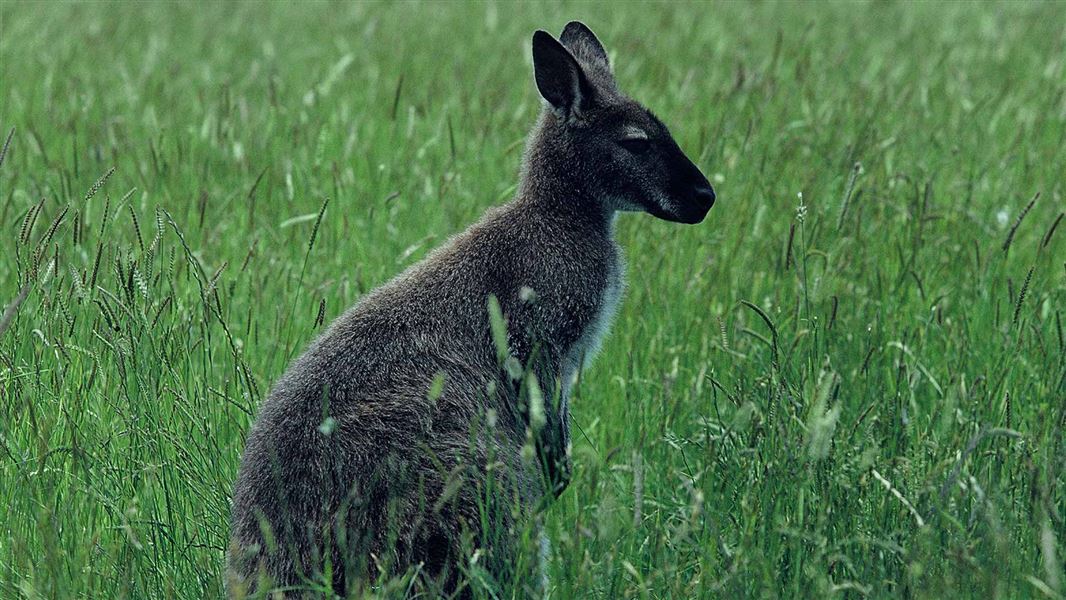There were introduced to New Zealand mainly for sport and the value of their skins. Wallaby species in New Zealand include Bennett's, dama, parma, brush-tailed rock and swamp wallabies.
They are a significant pest because they browse on native plants which in turn negatively impacts forest regeneration. Wallabies do not have any natural predators so have adapted well in Aotearoa.
Threats
Wallabies are introduced herbivores. They:
- graze on pasture and browse on native plants
- eat everything that’s at their height in our native bush, including the seedlings that make up future native bush
- destroy productive farmland and forests, and reduce biodiversity in our iconic landscapes
- cost New Zealanders millions in lost farm production and the overall benefits we get from our environment.
Five species of wallabies were introduced to New Zealand from Australia in the late 1800s. They were brought here mainly for hunting and for people who had private zoos. They do not have any natural predators in this country and have adapted well.
Three of these species have become significant pests:
- the dama wallaby and parma wallaby in the North Island (found mainly around the Rotorua Lakes area)
- the Bennett's wallaby in the South Island (found mostly in South Canterbury but spreading to other areas).
More information on controlling pest wallabies MPI website
Our work
Tipu Mātoro National Wallaby Eradication Programme works to reduce the spread of wallabies and ultimately eradication. DOC partners with central and local government agencies working with iwi, farmers, landowners, researchers, and communities
More information on Tipu Mātoro
You can help
Your help locating wallabies is valuable to their control and helps protect our native species, forests, farmlands, and iconic landscapes. If you've seen a wallaby, dead or alive, report it using the form below.
Sighting reports - Tipu Mātoro
Pest wallaby species in New Zealand
Dama wallaby
(Macropus eugenii)
Size: Head and body length reaches 53 cm in males and females 49 cm with tail lengths 38 to 42 cms. Average weights are 5 to 6 kg for males and 4 to 5 kg for females.
Colour: Grey brown upper body, paler grey underside with rufous shoulders. Tail tapering and uniform grey.
Social behaviour: Forms small groups.
Reproduction: Females sexually mature at 12 months old. Most births January/February with young staying in the pouch for 250 days.
Gestation period: 28 days.
Birthing: January/February.
Bennett's wallaby
(Macropus rufogriseus rufogriseus) Often called red-necked wallaby.
Size: The larger of the three species available standing 800 mm tall with a head and body length of 65 cm and tail length of 62 cm. Males can reach 20 kg plus in weight with females reaching 14 kg.
Colour: Greyish brown upper body with pale grey on the chest and belly. Rufous colour on the shoulders, black tipped hind feet and tail.
Social behaviour: Solitary.
Reproduction: Males sexually mature at 21 – 22 months, some earlier, and females 23 – 24 months. Young stay in the pouch for about 274 days.
Gestation period: About 30 days.
Birthing: Peak season February to March.
Nomenclature: Male= buck. Female = doe. Young = joey.
Parma wallaby
(macropus parma)
Size: Head and body length reaches 53 cm in males and females. Tail length for males 49 to 54 cm and females 41 to 51 cm. (About the same length as head and body). Average weights are 4 to 6 kg for males and 3 to 5 kg for females.
Colour: Grey-brown, with white throat and upper chest. Remaining underparts are greyish. Dark dorsal stripe running from forehead to mid-back often present. White tipped tail in about half of individuals.
Social behaviour: Normally solitary may feed in groups of 2-3.
Reproduction: Sexual maturity at 12 to 24 months.
Gestation period: 35 days.
Birthing: Breeding may occur throughout year, but most births occur between February and July
